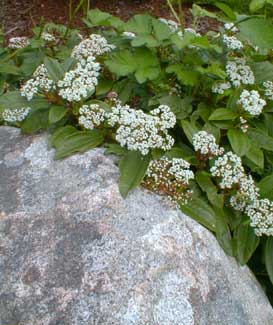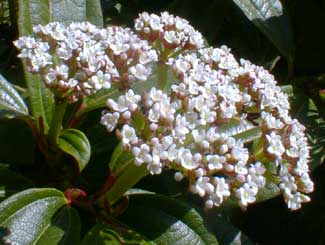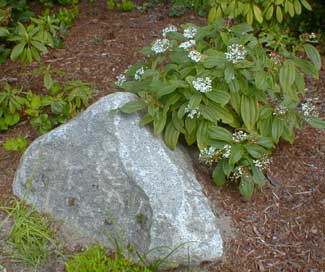
David Viburnum
"Come, Silence, thou sweet reasoner,
Lay thy soft hand on all that stir--
On grass and shrub & tree & flower,
And let this be thine own dear hour."
-James Herbert Morse
(1841-1923)
When the very first shrubs were planted by the original landscapers a few years before the current owners obtained the property for which I do occasional landscaping & gardening, a great many David Viburnums were planted all over tarnation. They were undoubtedly selected because they are such low-maintenance shrubs.(1841-1923)
While they certainly are attractive, they are overused in this region as parking-lot & sidewalk edging & traffic-island shrubs. If it were a rarer shrub I'd like it more, but a plant so often encountered on traffic islands wouldn't be my personal first choice.
 Yet there is no denying these are attractive shrubs. Among evergreen viburnums it is one of the prettiest. In a cared-for garden, their beauty far exceeds specimens stressed at the fringes of parking lots.
Yet there is no denying these are attractive shrubs. Among evergreen viburnums it is one of the prettiest. In a cared-for garden, their beauty far exceeds specimens stressed at the fringes of parking lots.In the garden where I snapped these photos one April, they are planted quite far apart rather than as groups, so my long-term plan for them was to fill in around them with more interesting shrubs so that the Davids become texture rather than focus.
Strongly evergreen, the broad pointed glossy leathery leaves have three nearly parallel indentation veins, which gives them a very interesting appearance. In winter these leaves take on a bronzy hue.
Tiny flowers occur in three-inch dome-shaped clusters or cymes, starting out as pinkish buds in winter but taking their time opening to off-white in May & June.
 Flowers are followed in summer by steely metallic-blue oval drupes on red pedicals. It sets fruit poorly unless there are two distinct clones to cross-pollinate, & both male & female plants must be present.
Flowers are followed in summer by steely metallic-blue oval drupes on red pedicals. It sets fruit poorly unless there are two distinct clones to cross-pollinate, & both male & female plants must be present.Unfortunately, in most landscapes, it is their cheapness & hardiness that got them considered, & there is usually only one clone of one sex present. So the showiest aspect of this shrub ends up being less than fully developed. I will be assessing these shrubs over time & if they are poor fruit producers, I will add partners for some of them to improve their performance.
It often remains under three feet tall & four wide, but can build up to five feet high & wide. It grows as a naturally tidy & compact dome that does not need pruning to keep a semi-formal shape.
If it ever does lose its shape or becomes too large, it can be hard-pruned to near the ground, & will grow back from the base. Moderate pruning or sheering, however, tends to ruin it by exposing the leafless center, & it's not smart enough to releaf precisely where one would wish. So sheering should not be tried; it's a hard pruning or none at all.
Native of Sichuan, China, it is suited for Zones 7 &mp 8, & might be tried in Zone 9 with a bit of protection. It likes full sun or partial shade. When established it is drought-hardy, but looks best if its drought-hardiness is not too greatly pressed. It loves the temperate weather patterns on Puget Sound & it loves our acidic soils, but it can be at risk in soil that drains poorly. In the main these will be low-maintenance shrubs requiring no special attention.